Facile “on water” domino reactions for the expedient synthesis of 2H-thiopyrano[2,3-b]quinolines†
Abstract
A facile synthesis of novel 3-nitro-2-aryl-2H-thiopyrano[2,3-b]quinolines from the domino reactions of 2-mercaptoquinoline-3-carbaldehyde and substituted β-nitrostyrenes in the presence of triethylamine (TEA) in water is described. This “on water” protocol proceeds with high atom economy through the creation of one C–S and one C–C bond presumably via a Michael addition-intramolecular aldol-dehydration domino sequence.
![Graphical abstract: Facile “on water” domino reactions for the expedient synthesis of 2H-thiopyrano[2,3-b]quinolines](/en/Image/Get?imageInfo.ImageType=GA&imageInfo.ImageIdentifier.ManuscriptID=C5RA04795A&imageInfo.ImageIdentifier.Year=2015)

 Please wait while we load your content...
Please wait while we load your content...